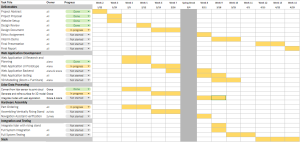Risks:
Using a laser-cut scissor lift that’s controlled electrically over a rotating stand allows for an easier time processing the readings from the scanner, as there would be minimal calculations to figure out the z-position of the scan. However, moving to this design, we run the risk of relying on the stability of the scissor lift to accurately move vertically. To manage the risk, we would need to test the sturdiness of the material we would use for the lift. Should we not get the lift working, we would mechanically lift the scanner.
Design Changes:
We have decided to go back to the idea of having a scissor lift to move our scanner to gather data. We received some feedback that it would be easier to implement and work with than the rotation method. While we haven’t pinpoint the exact cost yet, we hope to lower costs by taking advantage of school resources from classes we are in. Though should that fail, the supplies overall should not be too costly for our budget.
Schedule Changes and Updates:
We adjusted our schedule to include a section for lidar data processing so that we could include a clearer timeline for this component of our project. The next week will be focused on making changes to the code to generate a smoother, more defined model.

Developments:
This week’s progress was a lot of getting the important parts of our project to work and laying the groundwork for integrating them together moving forward. Creating a 3D point cloud is the most visually exciting things we have to offer this week, but the rest of the work is going towards making future stages run smoother.

